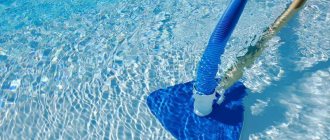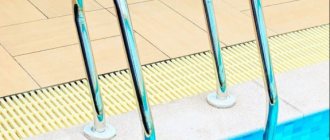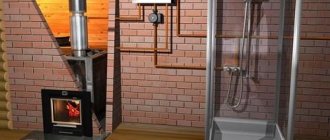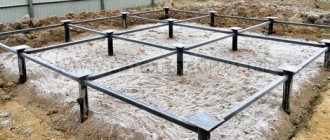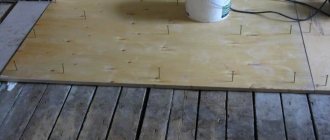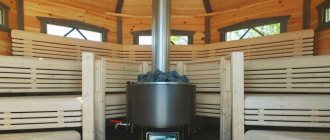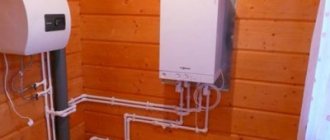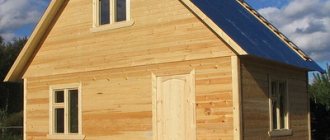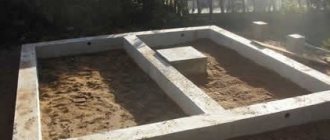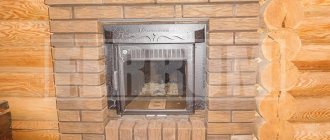On weekends, many residents of our homeland strive to quickly go to their dacha from their cities to breathe fresh air, enjoy nature and take a break from the bustle of the city. And if you have a swimming pool, then the question arises: How to heat a pool in the country?
Swimming in cold water is not fun. And if children also swim with you, they can easily get sick.
Let us remind you that the comfortable water temperature in the pool for an adult is from 25 degrees Celsius, and for children - from +29 degrees.
Today we’ll look at what methods we can use to heat a pool at the dacha. Moreover, we will consider both the devices offered by manufacturers and traditional methods.
Heating by electric heater
Electric flow heaters contain built-in heating elements. They are made of metal or anti-corrosion alloy. Water passing through them heats up more and more each time. The case is made of plastic, stainless steel or titanium. Powered by network. Models differ in power.
Electric heating installation diagram
Electric heaters are popular. Designed for small volume bowls.
Devices of this type have a maximum power of 18 kW. They are capable of heating up to 36 cubic meters of liquid.
Leaders of sells
Intex is a company that produces swimming pools and accessories for them. Water heaters are suitable for inflatable ponds.
A manually controlled thermostat is built in to regulate the heating temperature.
Bestway is the second most popular company. The device heats up the water in the dacha pool by 1.5°C in an hour. The equipment is low-power, designed for small volumes. You can buy models with or without a built-in thermostat.
Electric water heater Bestway
Pahlen is an instantaneous water heater with a power of up to 18 kW. For units above 3 kW, a connection to an electrical network with a voltage of 380 Volts is required.
The package includes a relay and thermostat. There is no need to regulate the water in the pool at your dacha. This happens automatically. There is an overheating protection system. Maximum heating up to 40°C.
Pahlen for water heating
Criteria for choosing a water heating device
The choice of a pool heating device must be approached with the utmost seriousness and be sure to pay attention to the following factors:
- Pool view. There are two types of pools: in the house (closed) and on the site (open). The second option will require equipment with increased power, since the process of cooling water in the open air occurs several times faster.
- Warm-up speed. The speed of water heating depends on the power of the device, however, more powerful devices are located in a high price category.
- Pool volume. For a small pool, a system with average power and heating rate is quite sufficient, and for large tanks, the opposite is true.
- Operational life. A device with high power and an increased degree of heat transfer will help you use the pool all year round. And for the summer period, especially on warm days, a device with average performance and heating speed will be sufficient.
The choice of water heater depends only on you!
From the above, we can draw a reasonable conclusion - the purchase of a specific water heating device directly depends on its technical characteristics and the selected type of pool.
Heating with wood
You can make a wood-burning pool heater at your dacha with your own hands. To do this, you will need a metal spiral through which water will circulate. A fire is made under it or inside. Operates using a circulation pump.
Water can be heated using a wood-fired boiler
You can buy such a heater. The models are equipped with a combustion intensity regulator and differ in power.
Advantages of the method:
- cheap fuel;
- quick installation;
- ease of use;
- fast heating.
The disadvantage of heating from logs is the complete lack of automation. Constant monitoring of firewood and its burning rate is required. Temperature cannot be set .
There are other fuel heaters - gas, diesel. When operating them, fire safety rules must be observed.
You can make a wood heater with your own hands from scrap materials
Lifetime.
Spirals made of stainless steel are not subject to corrosion, even when used in salt pools with cleaning based on a chlorine generator, their corrosion will be less than 0.01 mm/year. Thus, the service life of a pool heater is practically unlimited and is at least 15-20 years.
| Stainless steel pipe |
Spirals made of black steel are susceptible to corrosion and aggressive environments, so their service life is much shorter than that of stainless steel spirals and averages 5-7 years. Termopool does not manufacture heaters from stainless steel
| Hot rolled pipe. |
Heating with solar collectors
To heat a swimming pool at your dacha, you can use solar energy. You can heat water indoors and outdoors. 3-5 hours are enough for it to reach the desired temperature.
Solar collectors for heating water in summer
To create a heated system you need special equipment. Modules in the form of a screen or tube. Operating principle of solar panels:
- black collectors intensively absorb sunlight;
- from the energy received, water reaches high temperatures;
- after warming up to the desired degree, the circulation pump starts.
Models with three-way automatic valves are available. They ensure uninterrupted circulation of coolant throughout the system.
Worth knowing! It is advisable to use solar collectors in those regions where there are many sunny days. In cloudy weather, efficiency decreases.
Installed solar panels for heating water
A similar device can be made using a regular black hose. You will need about 40 meters of material, a circulation pump and a flat area:
- the hose is twisted into spirals and laid at an angle to the sun on the surface;
- a pump is connected to it;
- the structure is connected to the pool.
Tips for using a heating system
Those who think that you just need to install a solar water heater and then use the free energy without worry are a little mistaken. The fact is that the solar collector, like any other equipment, needs periodic maintenance. First of all, this concerns cleaning glass from dust. Even slight contamination will reduce the power of the unit by 5–8%. If you do not clean the surface of the installation at all, then in a few weeks the temperature of the water leaving the device will drop by a quarter.
The second thing you will have to regularly monitor is the condition of the threaded connections in an installation made of metal-plastic pipes. The fact is that regular heating-cooling cycles contribute to loosening of fittings, and this leads to depressurization of the system and the appearance of leaks. Therefore, once every 2–3 weeks, while the centrifugal pump is operating, all manifold connections are inspected. Do not forget that the installation is assembled from plywood, lumber and steel, and all these materials and a warm, humid environment are incompatible. Therefore, timely troubleshooting will extend the life of the water heater and preserve its appearance.
At the end of the summer season, the water from the solar collector is drained, after which the installation is covered from precipitation with a thick plastic film, or even put away under a shed or in a barn.
Circles of black film floating on the surface of an outdoor pool will help the geocollector heat the water to a comfortable temperature
The last thing I would like to remind you is that it is not enough to heat the water. It is important to preserve this heat for as long as possible. If possible, a covered pavilion is built over the artificial reservoir. If finances do not allow installing a permanent shelter, then the pool is covered every evening with a special awning or plastic film. In addition to the fact that the blanket will be able to retain a few extra degrees until the morning, it will also serve as a protective barrier, preventing leaves, insects and dust from getting into the water. A good help for a solar collector are circles made of black plastic film stretched over a hula hoop. When laid on the surface of the water during the daytime, they will provide additional heating of the water and protection from debris. The only inconvenience is that you have to remove them every time before bathing.
Heating by heat pump
Another heating method is a heat pump. The water warms up quickly. Electricity is consumed to operate the pump and compressor.
Heat pump connection system
Operating principle:
- heat source - industrial, domestic wastewater, thermal springs or flue gases;
- the liquid circulates through a pipeline laid underground;
- then it enters the heat exchanger, where heat is transferred to the refrigerant and it boils;
- Next comes the formation of masses of steam, which are transferred to the compressor and compressed to 25 atmospheres;
- Having passed around the circle, the water returns to the bowl.
Positive aspects of technology:
- high power;
- free energy sources;
- saving money during operation;
- fast heating.
The only negative is the high price of the equipment.
Heat pump system for water heating
Heating by gas boiler
Gas boilers are used to heat large swimming pools. The principle of operation of such water heaters is similar to fuel ones, however, it is not wood or coal that burns, but natural gas or propane. In such devices, water from the pool is pumped into the boiler storage tank. The burning gas releases heat to the liquid. The heated water returns to the pool. Fluid circulation occurs.
Heating with a gas boiler is needed for large swimming pools.
The advantage of this device: even if there is a lot of water in the pool, it will heat up quickly. The disadvantages of gas boilers include the need to obtain permission to install equipment. Installation should only be carried out by a specialist.
Several solar heater options
To make a productive and interesting option you will need the following components:
- black sheet of cellular polycarbonate;
- polypropylene pipe with a diameter of 25 mm;
- fittings, their number and parameters will depend on the specific configuration;
- circulation or drainage pump;
- filter.
The manufacturing sequence will be as follows:
- You need to take two pieces of pipe. Their length should be 7 cm greater than the width of the polycarbonate sheet.
- At one end of each segment, an adapter MPH (or MPB, everything will depend on how the connection needs to be ensured) is soldered.
- On the other side, the pipe is closed with a plastic plug.
- Markings are made along the pipe. Two lines are drawn. The distance between them should be equal to the thickness of the plastic sheet.
- The pipes are fixed in a vice so that they cannot be moved. Using a grinder, the slits are made.
- Prepared elements are put on one and the other side of the cellular polycarbonate.
- The joints are coated with glue that is resistant to water.
- The entire structure is left for a certain period of time so that complete setting occurs.
- The resulting unit must be placed on the roof at an angle. The direction of the internal channels should go along the sheet.
- The supply pipe is connected to the lower part, and the outlet pipe is connected to the upper part.
- A pipe is lowered into the pool to the very bottom. The cartridge from the filter flask is attached to it. In another option, you can cut off the neck of a 2 liter bottle 15 cm long. Put a stocking on the open part and secure it with a tie. A hose is connected to the other part. It is discharged to the circulation pump.
- A pipe is connected to the second outlet of the pump from the bottom of the collector.
- A pipe from the top of the collector is connected to the pool so that the filling occurs from above.
- In order to start the entire mechanism, it must be partially filled with water so that the pump can pick up the current.
Two layers of polycarbonate
Pipe sections with fittings and hoses
Adapter
The pipe is fixed, slots are made
Polycarbonate is inserted
Polycarbonate water heater
The essence of the operation is that cold water is taken from the bottom of the pool and supplied to the lower part of the cellular polycarbonate. Passing through its entire area through small channels, it warms up and returns again to the container. With a seam size of 6x2 m, the power reaches approximately 7 kW.
Another heating mechanism is also quite simple to manufacture. For it you will need:
- metal-plastic pipe with a diameter of 16 mm;
- glass;
- black spray paint, temperature resistant;
- edged board 10×3 cm;
- screwdriver;
- self-tapping screws;
- galvanized metal sheet measuring 1×2 m;
- wood hacksaw.
The entire structure is assembled as follows:
- Two pieces 2 m long are cut out of the board. The other two pieces should be 1 m each.
- They twist together into a rectangle.
- The back part is covered with sheet metal.
- The inside is coated with black paint, which will attract more sunlight.
- The entire space of the structure is conditionally divided into two parts. In each of them it is necessary to lay a metal-plastic pipe, which will be wound in the form of a snail.
A similar option:
Two circuits are connected to form one closed system.- To secure the pipe, restrictive bars made of wood or other material are attached to the sides.
- Everything inside is painted again with black spray paint.
- A cutout is made in one of the end walls and a feed pipe is passed through. You should do the same from the opposite end diagonally.
- The top of the box is closed with ordinary glass. This will make it possible to increase the temperature to the maximum possible value.
- A pump is installed near the pool. You can use a self-priming centrifugal one. He is not afraid of airing. It will also successfully draw in water and supply it upward.
- The collector is installed at an angle of 30° towards the sun. It is advisable to place it on the roof.
- A hose is lowered into the pool and a filter barrier is made on it, as described above. The pipe is connected to the pump. A pipe is connected to the second outlet to supply liquid upward.
- From the collector, the pipe descends directly into the pool.
Water, passing through the coiled sections of pipe, manages to warm up well and subsequently gives off its temperature to the liquid that is in the container. The turns may not necessarily be arranged as described above. You can make a larger structure and lay the pipe in a snake or other pattern that will ensure maximum heating.
To automate the entire process, the pump can be connected to a special timer. Make settings on the device in such a mode that it starts functioning only during the day. The supercharger will turn on on its own and you won’t have to worry about uncomfortable conditions.
How to quickly heat water in a swimming pool at your dacha with your own hands
Before heating the water in the pool, you need to know what the optimal temperature should be for specific purposes. If:
- adults will swim, then +24…28 °C;
- there will be children under 7 years old, then +30...32 °C;
- children from 7 years old will swim, then +29…30 °C;
- for use for health purposes, then +26…28 °C;
- for taking hydromassage baths +35…39 °C.
During the hot season, the water in the pool warms up naturally. Heating is necessary when the air temperature drops. Electricity, solid fuel, and gas are used to heat artificial reservoirs. When choosing the most suitable option, you need to focus on the following points:
- Heating rate. It is faster to achieve a comfortable water temperature for electrical devices. But powerful heaters don't come cheap.
- Type of reservoir. Unlike open-type pools, closed ones warm up easier and faster.
- Volume. Large structures will require the use of serious equipment, powerful and expensive.
- Frequency and seasonality of use. If there is a need to heat water throughout the year, then install equipment with a high level of heat transfer.
Electric heaters
The active use of electrical devices for heating water is due to a number of advantages:
- compact sizes;
- affordable cost;
- ease of use;
- good speed;
- resistance to temperature changes.
An electric heater makes it possible to quickly heat a pool at home. Heating of the liquid occurs as it passes through the tubes, which are heated by the dielectric. The pump included in the kit ensures that water is driven into the heating element. You can adjust the degree of heating of the tubes by adjusting the speed of liquid movement.
It is good to use an electric heater for swimming pools with a volume of no more than 30 m3
Heat exchanger
It is also effective to heat water in a pool outside using a heat exchanger, where one liquid exchanges heat with another. This process requires a water heater installed either indoors or near a reservoir. The most commonly used gas water heater is a heating system. The device can be presented in the form of a cylinder; water from a home pool is pumped into it. It has a spiral through which already hot liquid passes. So water for heating a home is also used to heat a country pool.
This option is economical and easy to use. There will be lower financial costs if you use gas and firewood. The undeniable advantage of the heat exchanger is the ability to heat water in a pool of any size. The effect can be enhanced by installing an auxiliary heat exchanger. Among the disadvantages, it is worth noting the seasonality of operation of the device - cold periods of the year. In summer the house does not need heating.
Paired with a heat exchanger, it is worth using thermal sensors equipped with an automatic control unit, as a result - energy saving and stable temperature
Heat pump
Heating water in an outdoor pool is simple and easy if you install a heat pump. This method is innovative, it does not require a lot of electricity consumption, and it is also possible to heat an artificial reservoir of any size. Everything from soil to hot air masses is used as heat sources. These are all kinds of natural ingredients.
Based on the principle of operation, a heat pump is similar to a refrigerator, only in reverse. Its task is to convert the surrounding air into heat, due to which a lot of energy is released, which can significantly increase the temperature of the liquid.
The heat pump has proven itself to be a safe device that operates from a household outlet
The device can be located either deep underground or on the surface. The system is able to function continuously.
solar collector
You can effectively heat the water in the pool using solar energy. The use of panels allows you to heat the liquid up to 140 °C. Inside the structure there is a coil through which water circulates, absorbing solar heat and returning to the reservoir.
To better heat the water in the pool, it is necessary to correctly calculate the dimensions of the collector. If the artificial pond is installed indoors, then you will need a panel of 50-70% of the volume of the pool, and for an outdoor option - up to 70-100%.
Among the advantages of a solar collector it is worth noting:
- availability;
- there are no difficulties with clearing the surface of snow;
- high degree of efficiency (especially in summer);
- ease of care;
- Possibility of installation at any angle.
The disadvantages of panels include:
- difficulties in case of breakdown;
- the degree of productivity decreases during cold periods of the year;
- moderate resistance to adverse environmental factors.
To install solar panels, you need to allocate enough free space on the site
Snail
This device is a reduced modification of the solar collector. The principle of operation is the same, water is taken through pipes in which it is heated and returned back to the artificial reservoir. You can make a snail at home.
A snail is an inexpensive and effective device for heating a pool. Tip! The simplest and most inexpensive way to heat a hot tub is with a snail. It is easy to maintain and does not require expensive repairs.
How to heat water in a large frame pool
It is best to heat the water in a frame pool by installing a heat pump made in the form of a monoblock. This outdoor block contains heat exchangers, each of which has an outlet into the pump housing. The connection process is quite simple, you need:
- Install a heat pump.
- Connect the power supply cable.
- Connect 2 or 4 flexible connections, for example, “giant” to the “supply” and “return” outputs of the pump, heating system, hot water supply.
- Connect the controller.
- Turn on and adjust.
Heating a frame pool at your dacha is easy and simple if you adhere to the following scheme.
The fuel pump connection diagram will help you carry out the work without errors.
How to heat water in a children's pool
It is possible to heat a small swimming pool at your dacha with your own hands by using a boiler or electric kettle. Alternatively, you can simply boil water on the stove. When working with electrical appliances, it is imperative to follow the rules of caution. If the hot tub is inflatable or made of plastic, then the tubular heater must not be allowed to come into contact with the material.
How to heat water in a swimming pool without electricity
The use of electrical devices greatly simplifies the process of heating a reservoir in the country. But there are other, no less effective ways.
Special coating
To heat water in a frame pool faster and without hassle, you can use a floating blanket. This dark film with bubbles is simply laid on the surface of the reservoir and left overnight. No auxiliary fastenings are required here. If used during the daytime, you can expect the effect after just a couple of hours.
Wood heating
A stainless steel coil is used to heat the reservoir, where one end must be connected to the opening of the font, and the other to the pump. The coil is mounted in a tank with firewood.
Video on how to heat water in a pool:
Specifications
Further:GO TO CATALOG › TO GET A CONSULTATION > |
Attention!Precautionary measures:Pool heaters - TERMOPOOL, can only be used with the pump turned on; if the pump is turned off, then gradually (in small portions) fill the fire with water until it goes out completely, to avoid negative consequences!!! If you do not put out the fire, the water in the spiral will heat up to a boil and begin to throw portions of boiling water into the pool, which can lead to burns!!! Fire safety rulesInstall the pool heater no closer than 5 meters from buildings, especially wooden ones. Make sure to keep flammable liquids and objects within 2 meters of the heater. The rest area around the heater, approximately 10 meters, should be cleared of dry grass. Try not to leave the heater unattended (especially during intense combustion); if you need to leave, ask an adult to supervise the operation of the water heater. It is prohibited to install heaters under tree branches. |
System requirements
Wood burning
Water is the environment in which the human body relaxes and rests in the best possible way. But, in addition, it is in such conditions that there is a danger of getting injured, which can become disabling. For this reason, the heating system must meet the basic requirements:
- relatively high heating rate;
- good insulation in case of electric current;
- minimal implementation costs;
- safety from an environmental point of view;
- possibility of continuous use;
- ease of self-assembly;
- availability of all components;
- absence of complex mechanisms;
- ease of repair.
In most cases, it will not be possible for a particular mechanism to meet all of the above points, but if at least 80% of them are covered, then such a solution can be considered very productive.
